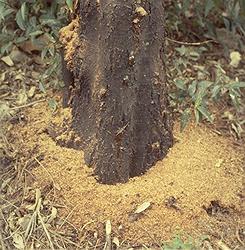Wood Borers

Borer infestations often go unnoticed until plants or parts of plants begin to die or show external signs of damage. Wood-boring insects often produce sawdust-like frass (excrement). Their holes are normally round, oval or semicircular and are found in a random pattern on the plant. Woodpecker damage is sometimes confused with that of wood-boring beetles; however woodpecker damage will not produce frass. One woodpecker, the yellow-bellied sapsucker, produces square holes in rows around a trunk or branch.
Many borers damage plants by tunneling through the inner bark layer (cambium) into the sapwood (xylem) that transports nutrients and water to the leaves. These insects are called phloem feeders. When the cambium layer is completely girdled the plant eventually dies above or beyond the damage site. Partial girdling reduces plant growth and vigor above the site of attack. On occasion, tunneling makes the tree weak, causing limbs and branches to fall. Borer damage can severely affect the quality of lumber and can make trees susceptible to disease.

